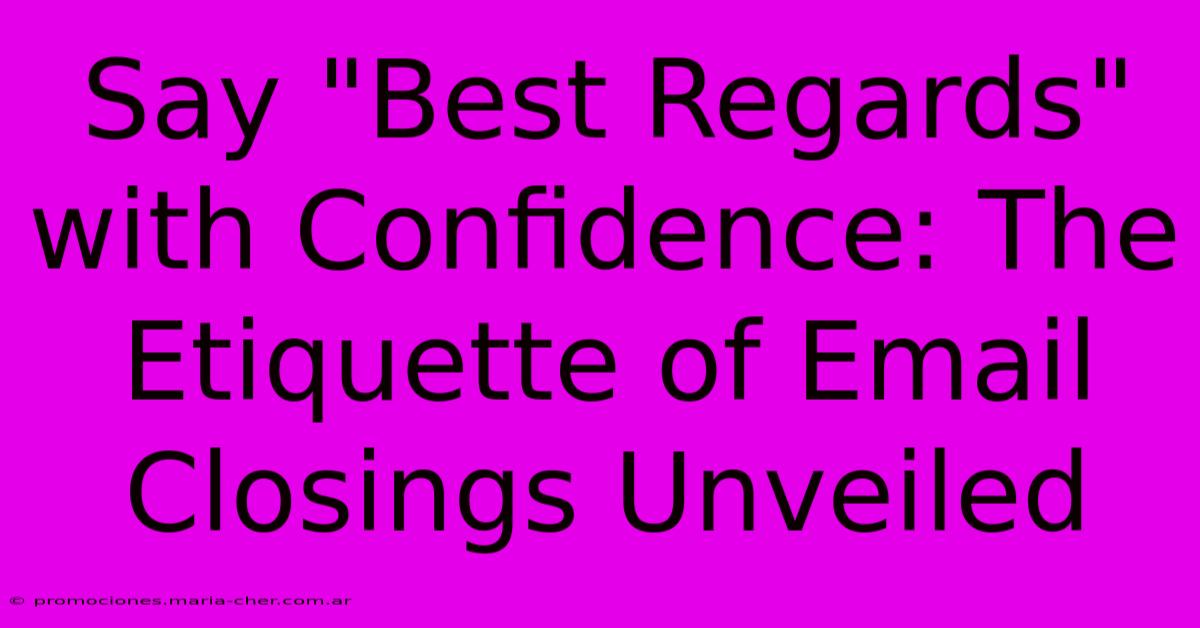Say "Best Regards" With Confidence: The Etiquette Of Email Closings Unveiled

Table of Contents
Say "Best Regards" with Confidence: The Etiquette of Email Closings Unveiled
Choosing the right email closing can feel surprisingly tricky. A simple sign-off might seem insignificant, but it's a final impression that can impact how your message is received. This guide unveils the etiquette surrounding email closings, focusing on when to use "Best Regards" and offering alternatives for various situations. Mastering this subtle art can significantly boost your professional communication.
Understanding the Importance of Email Closings
Your email closing isn't just a formality; it's a crucial element of professional communication. It reflects your personality, professionalism, and the overall tone of your message. A poorly chosen closing can undermine your carefully crafted content, while a well-chosen one can leave a lasting positive impression.
First Impressions and Lasting Impacts
Think of your email closing as a handshake in the digital world. Just as a firm handshake conveys confidence, the right closing reinforces the professionalism and respect you've established throughout your email. Conversely, a careless or inappropriate closing can leave the recipient with a negative impression, potentially damaging your professional reputation.
When to Use "Best Regards"
"Best Regards" is a classic and versatile closing suitable for a wide range of professional communications. It conveys politeness and respect without being overly formal or informal. Here's when it's a perfect choice:
- Professional Correspondences: Use "Best Regards" when communicating with colleagues, clients, superiors, or business partners you have a professional relationship with, but not necessarily a close personal one.
- Neutral Tone Emails: This closing works well for emails that aren't overly positive or negative, such as informational updates, requests for information, or routine correspondence.
- Formal Situations: While not excessively formal, "Best Regards" fits well in more formal communication scenarios compared to more casual options.
Alternatives to "Best Regards" – Choosing the Right Closing
While "Best Regards" is a safe and effective choice, other options exist, depending on your relationship with the recipient and the context of your email.
More Formal Closings:
- Sincerely: This is a highly formal and respectful option, ideal for official communications or when addressing someone of significantly higher seniority.
- Respectfully: This conveys deference and respect and is appropriate for formal communications and situations where you need to express particular respect.
Less Formal Closings:
- Regards: A slightly less formal alternative to "Best Regards," suitable for colleagues you know well.
- Kind Regards: A warmer and friendlier alternative, appropriate for colleagues and clients you have a more established relationship with.
- Warmly: Suitable for close colleagues or clients with whom you have a friendly and informal relationship.
Informal Closings (Use with Caution):
- Thanks: Use only when the email is primarily thanking someone.
- Cheers: Appropriate only in informal settings with people you know very well. Avoid this in professional contexts unless your workplace culture explicitly allows it.
Crafting the Perfect Email Signature
Your email signature is an extension of your email closing. It should be professional, concise, and include your:
- Full Name: Clearly and prominently displayed.
- Job Title: To provide context and credibility.
- Company Name: For easy identification.
- Contact Information: Phone number and professional email address.
- Website (Optional): Include your company website or personal professional website, if applicable.
Avoid cluttered or overly long signatures that distract from your message.
Conclusion: Mastering Email Etiquette
Choosing the right email closing is a subtle but important aspect of professional communication. By understanding the nuances of different closings and tailoring your choice to each situation, you can project confidence, professionalism, and build stronger relationships through your digital correspondence. Remember, attention to detail in these seemingly small elements can significantly impact your overall professional image.

Thank you for visiting our website wich cover about Say "Best Regards" With Confidence: The Etiquette Of Email Closings Unveiled. We hope the information provided has been useful to you. Feel free to contact us if you have any questions or need further assistance. See you next time and dont miss to bookmark.
Featured Posts
-
Change The World One Child At A Time Join The Compassion Force
Feb 10, 2025
-
Gift Happiness On A Budget Unlock The Secret Fifty Flowers Promo Code
Feb 10, 2025
-
Grammar Mastermind The Definitive Guide To Which And Wich
Feb 10, 2025
-
Break The Overexposure Cycle Find Balance In A Stimulus Saturated World
Feb 10, 2025
-
Harvest Harmony Create Enchanting Nail Art With The Autumnal Symphony Of Dnd Gel Nail Polish
Feb 10, 2025
